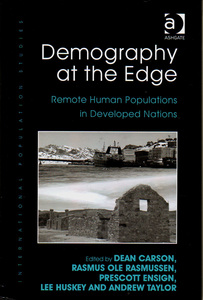Weather hazards, place and resilience in the remote Norths
Harwood, Sharon, Carson, Dean, Marino, Elizabeth, and McTurk, Nick (2011) Weather hazards, place and resilience in the remote Norths. In: Carson, Dean, Rasmussen , Rasmus Ole, Ensign, Prescott, Huskey, Lee, and Taylor, Andrew, (eds.) Demography at the edge: remote human populations in developed nations. International Population Studies . Ashgate Publishing, Surrey, England, pp. 307-320.
![[img]](https://researchonline.jcu.edu.au/19208/3.hassmallThumbnailVersion/19208_Harwood_et_al_2011_Book_Cover.jpg)
|
Image (JPEG) (Book Cover)
- Cover Image
Download (98kB) |
|
|
PDF (Published Version)
- Published Version
Restricted to Repository staff only |
Abstract
[Extract] For centuries people have been on the move, the temporal and spatial extent of these movements varies considerably between people and the places that they inhabit. Movement from one location to another can be explained in terms of biological needs (Tuan 1977), whereby animals including human beings pause at a location because it satisfies certain biological needs (Tuan 1977: 138). The biological needs may be social, economic, spiritual or cultural by nature; however, if these needs are not met then the movement recommences. The movements can be attributed to seeking alternate sources of food, escaping inhospitable weather, moving to gain a new job or seeking life 're-creating' experiences through tourism. This paper examines movement that is the result of being unable to meet biological needs such as the inability to access employment, safe shelter and food because of the effects of weather events. Bronen (2009) describes the two possible responses to weather related movements as climigration and migration. Climigration describes the forced permanent migration of communities due to climate change (Bronen 2009) and an inability to return to their home because their home is either under water or sinking, and migration describes the temporary relocation of individuals subsequent to a catastrophic weather event such as a cyclone.
The purpose of this chapter is to explore population mobility of the remote Norths with a specific focus on climigration and migration and how these in turn may affect the vulnerability and resilience of a community. The chapter contrasts the responses of a community within a hazard risk resilience framework to a one off extreme weather event to another community that responds to the more enduring impacts associated with global climate change. The case example of Shishmaref, a village in Alaska, by Elizabeth Marino describes the characteristics of the population, the implications of cross cultural dialogue in planning the 'relocation' mitigation response to climate change, and the need to find a place to relocate to that possesses all of the physical and cultural values that enables the community to function as they did prior to the relocation. The Katherine case example is taken from Dean Carson's research on the effect of cyclone Les on the size and composition of the population subsequent to a catastrophic weather event. Katherine, a town in Northern Territory, Australia, lost specific groups that underpinned the local economy as a result of the cyclone and these were subsequently replaced by Indigenous people that while not engaged in employment created an increased demand for health, education and government services.
| Item ID: | 19208 |
|---|---|
| Item Type: | Book Chapter (Research - B1) |
| ISBN: | 978-0-7546-7962-2 |
| Date Deposited: | 26 Mar 2012 00:20 |
| FoR Codes: | 16 STUDIES IN HUMAN SOCIETY > 1604 Human Geography > 160403 Social and Cultural Geography @ 100% |
| SEO Codes: | 96 ENVIRONMENT > 9610 Natural Hazards > 961099 Natural Hazards not elsewhere classified @ 100% |
| Downloads: |
Total: 1278 Last 12 Months: 3 |
| More Statistics |




